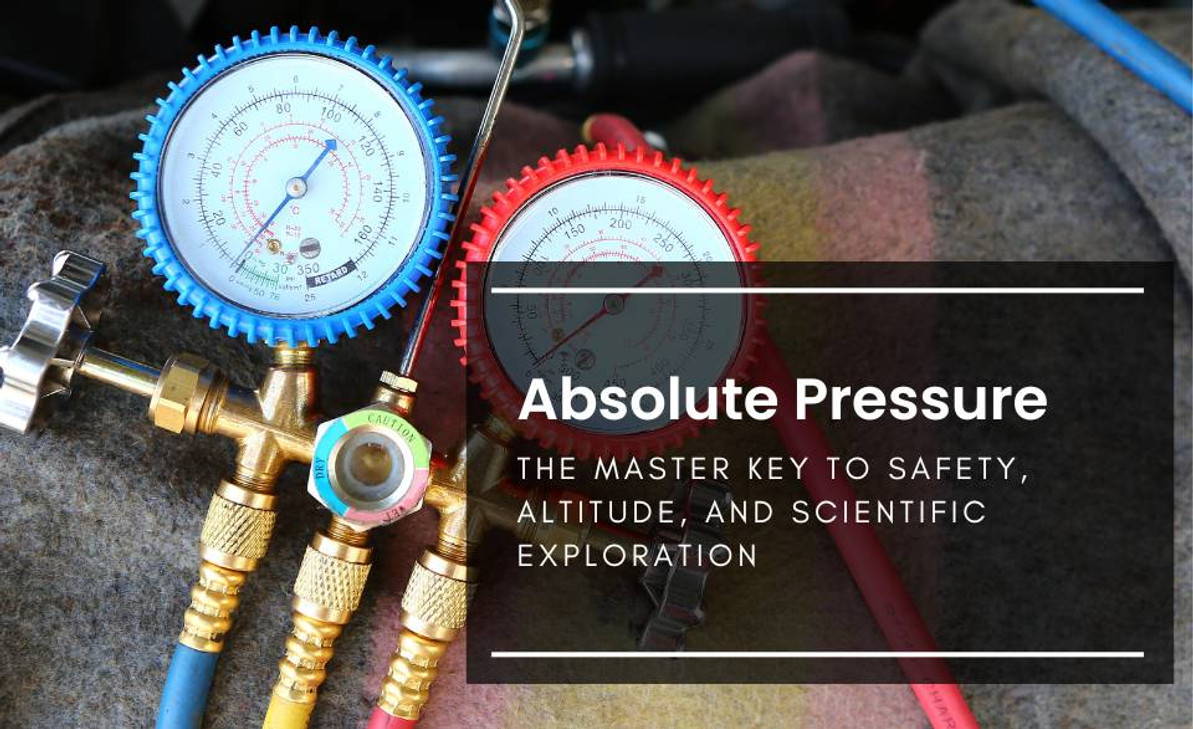Absolute Pressure: The Master Key to Safety, Altitude, and Scientific Exploration
Are you curious about the force exerted by fluids and how it relates to atmospheric conditions? Welcome to the world of absolute pressure! Whether you want to understand tire pressure, weather forecasting, or even scuba diving, Absolute pressure is a key concept. In this introduction, we'll explore the basics of Absolute pressure, its applications, and why it matters in various fields. Get ready to dive into the fascinating world of pressure measurements!

Fig 1. Pressure types
What is absolute pressure?
Absolute pressure refers to the total pressure exerted by a fluid, including both the atmospheric pressure and the pressure generated by the fluid itself. It is the measurement of pressure relative to a perfect vacuum.
In practical terms, absolute pressure is the pressure measured concerning absolute zero pressure, which corresponds to a complete absence of any gas or fluid. It is usually expressed in units such as pascals (Pa), pounds per square inch (psi), or bar.
To understand the concept better, consider a laboratory vacuum chamber. When measuring the pressure inside a vacuum chamber, it gives you absolute pressure. This means it measures the pressure inside the chamber in addition to the atmospheric pressure acting on the outside of the chamber. If the gauge reads 50 kPa, it means the pressure inside the chamber is 50 kPa above atmospheric pressure.
Absolute pressure is particularly important in scientific and engineering applications where accurate pressure measurements are required, such as in industrial processes, weather forecasting, and fluid dynamics. It provides a standardized reference point for measuring and comparing pressures.
What is the SI unit of absolute pressure?
The SI (International System of Units) unit of absolute pressure is Pascal (Pa). The Pascal is defined as the pressure exerted by a force of one newton per square meter. It is named after the French mathematician and physicist Blaise Pascal.
In scientific and engineering contexts, Pascal is commonly used to express absolute pressure. However, other units such as bar, kilopascal (kPa), and megapascal (MPa) are also frequently used, especially in industrial applications and engineering disciplines.
It's important to note that conversions between different pressure units can be performed using conversion factors. For example, 1 bar is equal to 100,000 pascals (Pa), or 1 kilopascal (kPa) is equal to 1,000 pascals (Pa).
Browse our wide selection of Pressure Sensor to find the perfect one for your application.
How can you measure the absolute pressure?
Absolute pressure can be measured using various instruments and techniques. Here are a few commonly used methods:
- Mercury Barometer: A mercury barometer is a traditional instrument used to measure atmospheric pressure. It consists of a long glass tube filled with mercury, inverted into a dish of mercury. The pressure exerted by the column of mercury measures the atmospheric pressure, and this reading represents the absolute pressure.
- Bourdon Gauge: Bourdon gauges are mechanical devices commonly used to measure pressure in industrial applications. They utilize a flattened, curved tube (Bourdon tube) that straightens when subjected to pressure changes. The tube's movement is then converted into a pressure reading on a calibrated dial, indicating the absolute pressure.
- Manometer: A manometer is a simple instrument that measures the pressure of a gas or liquid. It consists of a U-shaped tube filled with a liquid (typically mercury or a colored fluid). The pressure being measured is applied to one end of the tube, causing the liquid to move and create a height difference between the two arms of the U-tube. The height difference can be correlated to the absolute pressure using appropriate conversion factors.
- Absolute Pressure Transducers: These are electronic devices that directly measure absolute pressure. They utilize various sensing technologies such as strain gauges, capacitance, or piezoelectric materials to detect pressure changes. The transducer converts the pressure into an electrical signal, which is then processed and displayed as a pressure reading.
- Digital Pressure Gauges: These are modern instruments that provide direct readings of absolute pressure. They typically incorporate a pressure sensor and digital display. The pressure sensor measures the pressure, and the value is displayed on the screen in the desired units, representing the absolute pressure.
It's worth noting that the specific method chosen for measuring absolute pressure depends on factors such as the range of pressures being measured, the level of accuracy required, and the environmental conditions in which the measurement is taking place.
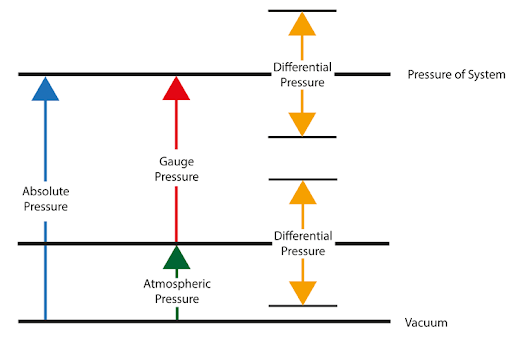
Fig 2. Pressure scale
Absolute pressure formulas
To calculate absolute pressure, you can use the following formulas:
Absolute Pressure = Gauge Pressure + Atmospheric Pressure
This formula is used when you have the gauge pressure (pressure measured relative to atmospheric pressure) and want to determine the absolute pressure. You simply add the gauge pressure to the atmospheric pressure.
Absolute Pressure = Pressure at a Depth + Atmospheric Pressure
This formula applies when you are dealing with pressure at a specific depth below the surface of a fluid (e.g., water) and want to find the absolute pressure. The pressure at a depth is determined by the density of the fluid, the acceleration due to gravity, and the depth itself. Adding the atmospheric pressure to the pressure at a depth gives you absolute pressure.
Absolute Pressure = Pressure Measurement + Pressure due to Elevation + Atmospheric Pressure
When measuring pressure at different elevations (altitudes) above sea level, you need to account for the change in atmospheric pressure with elevation. The formula includes the pressure measurement, the pressure change due to the elevation, and the atmospheric pressure.
It's important to note that the units used in these formulas should be consistent (e.g., pascals, psi, bar) to obtain accurate results. Additionally, keep in mind that atmospheric pressure may vary depending on location and weather conditions, so accurate atmospheric pressure values are essential for precise calculations.
An example of using these formulas
Certainly! Let's consider an example using the formulas for calculating absolute pressure.
Example: You are scuba diving at a depth of 15 meters in the ocean. The gauge pressure reading on your dive computer shows 3.5 bar, and the atmospheric pressure at the surface is 1 bar. You want to calculate the absolute pressure at your current depth.
Using the formulas:
Absolute Pressure = Gauge Pressure + Atmospheric
Pressure Absolute Pressure = 3.5 bar + 1 bar Absolute Pressure = 4.5 bar
So, the absolute pressure at a depth of 15 meters would be 4.5 bar.
Alternatively, let's consider another example:
Example: You are measuring the pressure inside a closed container using a pressure gauge. The gauge reading shows 120 psi. The elevation of your location is 500 meters above sea level, and the atmospheric pressure at your location is 14.5 psi. You want to determine the absolute pressure inside the container.
Using the formulas:
Absolute Pressure = Gauge Pressure + Atmospheric Pressure
Absolute Pressure = 120 psi + 14.5 psi Absolute Pressure = 134.5 psi
Absolute Pressure = Pressure Measurement + Pressure due to Elevation + Atmospheric Pressure
Absolute Pressure = 120 psi + (500 meters * 0.0304 psi/meter) + 14.5 psi Absolute Pressure = 120 psi + 15.2 psi + 14.5 psi Absolute Pressure = 149.7 psi
In this case, the absolute pressure inside the container would be approximately 149.7 psi.
Remember to adjust the formulas and units according to your specific situation and the units you are working with.
Formulas table
Here's a table summarizing the formulas for calculating absolute pressure:
| Scenario | Formula |
| Gauge Pressure | Absolute Pressure = Gauge Pressure + Atmospheric Pressure |
| Pressure at Depth | Absolute Pressure = Pressure at Depth + Atmospheric Pressure |
| Pressure at Different Elevations | Absolute Pressure = Pressure Measurement + Pressure due to Elevation + Atmospheric Pressure |
Make sure to use the appropriate units and values for each variable in the formulas.
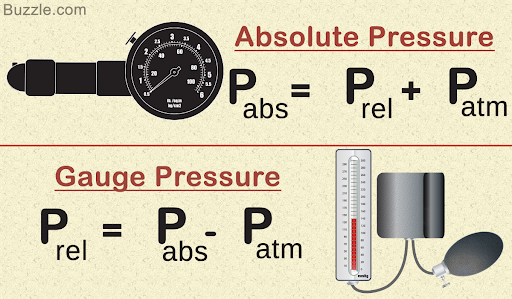
Fig 3. Absolute pressure formula
How can use absolute pressure?
Absolute pressure has various applications in different fields. Here are some examples of how absolute pressure is used:
- Industrial Processes: Absolute pressure is crucial in industrial processes that involve pressurized systems, such as manufacturing, chemical processing, and oil refining. It helps monitor and control pressure levels within the equipment, ensuring safe and efficient operation.
- HVAC Systems: Absolute pressure measurements are used in heating, ventilation, and air conditioning (HVAC) systems to determine the proper air pressure differentials for efficient airflow and ventilation.
- Weather Forecasting: Meteorologists use absolute pressure measurements to analyze and predict weather patterns. Changes in atmospheric pressure provide valuable information about the movement and intensity of weather systems.
- Altitude Measurement: Absolute pressure can be used to estimate altitude or elevation. By comparing the measured absolute pressure with standard atmospheric pressure values at different elevations, it is possible to approximate the height above sea level.
- Medical Applications: Absolute pressure is utilized in various medical devices and procedures. It is crucial in monitoring blood pressure, intracranial pressure, and respiratory systems, providing important diagnostic information, and guiding medical interventions.
- Aerospace and Aviation: Absolute pressure plays a vital role in aviation, especially in aircraft altimeters and cabin pressurization systems. It enables pilots to determine their altitude and ensures proper pressurization within the aircraft cabin for passenger comfort and safety.
- Scientific Research: Absolute pressure measurements are fundamental in scientific experiments and research involving fluid dynamics, material testing, and atmospheric studies. Accurate pressure data allows researchers to analyze phenomena and make informed conclusions.
These are just a few examples illustrating the broad applications of absolute pressure across various industries and disciplines. Its precise measurement is essential for maintaining safety, optimizing processes, and advancing scientific understanding in many fields.
How does absolute pressure relate to altitude?
Absolute pressure and altitude have a direct relationship. As altitude increases, the absolute pressure decreases, and vice versa. This relationship is a result of the change in atmospheric pressure with changes in altitude.
Atmospheric pressure is the pressure exerted by the Earth's atmosphere at any given point. It is caused by the weight of the air above that point. As you go higher in altitude, there is less atmosphere above you, and therefore, less air pushing down on you. This leads to a decrease in atmospheric pressure.
The relationship between absolute pressure and altitude can be explained as follows:
- As you ascend to higher altitudes, the atmospheric pressure decreases because there is less air above you to exert pressure.
- Absolute pressure includes both the pressure generated by the fluid (e.g., air) and the atmospheric pressure acting on it. Therefore, as atmospheric pressure decreases with altitude, the absolute pressure also decreases.
- Conversely, as you descend to lower altitudes, the atmospheric pressure increases because there is more air above you, exerting more pressure.
- Consequently, the absolute pressure also increases as you descend to lower altitudes.
This relationship is essential in various practical applications, such as in aviation, weather forecasting, and altitude measurements. For example, altimeters in aircraft measure absolute pressure to determine the aircraft's altitude above sea level. Meteorologists use the change in atmospheric pressure with altitude to predict weather patterns and changes in weather conditions. Understanding the relationship between absolute pressure and altitude is crucial in these fields to ensure safety, accuracy, and informed decision-making.
What is the reference point for measuring absolute pressure?
The reference point for measuring absolute pressure is typically a perfect vacuum. In other words, absolute pressure is measured relative to the complete absence of any gas or fluid pressure, where the pressure is zero. This idealized condition corresponds to the lowest possible pressure level, and it serves as the reference point for measuring all other pressures.
In practice, achieving a perfect vacuum is challenging, but for most applications, a sufficiently low-pressure level can be considered a practical approximation of a vacuum. The pressure at this reference point is considered to be absolute zero pressure.
When measuring absolute pressure, it is essential to account for atmospheric pressure if the measurement is being taken in an environment with air or other gases present. Absolute pressure includes both the pressure generated by the measured fluid and the atmospheric pressure acting on it.
By using the reference point of a perfect vacuum, absolute pressure provides a standardized and consistent method for measuring pressures across different applications and scenarios.
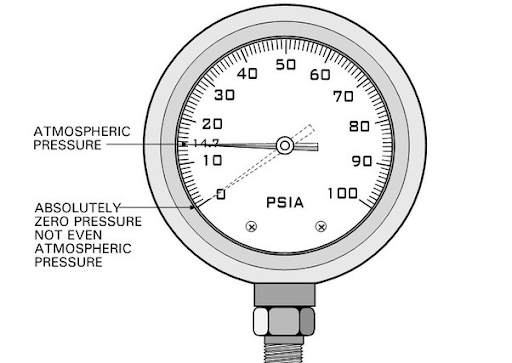
Fig 4. Pressure gauge
What are the absolute pressure types?
Absolute pressure types refer to different reference points or scales used when measuring absolute pressure. The two common types are
- Absolute Pressure (Absolute Zero Reference): This type of absolute pressure measurement uses a reference point of absolute zero pressure, which corresponds to a perfect vacuum. It is often denoted as "abs" or "absolute" and is the most commonly used type. Absolute pressure includes both the pressure exerted by the fluid and the atmospheric pressure acting on it.
- Sealed Gauge Pressure (SGP): Sealed gauge pressure is another type of absolute pressure measurement. It uses a reference point of a sealed system at atmospheric pressure. In this measurement, the atmospheric pressure is subtracted from the total pressure to provide a reading that reflects only the pressure exerted by the fluid or gas being measured. Sealed gauge pressure is denoted as "sg" or "sealed gauge."
It's important to note that while both types provide absolute pressure readings, they have different reference points and scales. The choice between total pressure and sealed gauge pressure depends on the specific application and the desired information needed from the pressure measurement.
What is absolute pressure used for?
Absolute pressure is used for various purposes across different industries and applications. Here are some common uses of absolute pressure:
- Industrial Processes: Absolute pressure is crucial in industrial processes that involve pressurized systems, such as manufacturing, chemical processing, and oil refining. It helps monitor and control pressure levels within the equipment, ensuring safe and efficient operation.
- HVAC Systems: Absolute pressure measurements are used in heating, ventilation, and air conditioning (HVAC) systems to determine the proper air pressure differentials for efficient airflow and ventilation.
- Weather Forecasting: Meteorologists use absolute pressure measurements to analyze and predict weather patterns. Changes in atmospheric pressure provide valuable information about the movement and intensity of weather systems.
- Altitude Measurement: Absolute pressure can be used to estimate altitude or elevation. By comparing the measured absolute pressure with standard atmospheric pressure values at different elevations, it is possible to approximate the height above sea level.
- Medical Applications: Absolute pressure is utilized in various medical devices and procedures. It is crucial in monitoring blood pressure, intracranial pressure, and respiratory systems, providing important diagnostic information, and guiding medical interventions.
- Aerospace and Aviation: Absolute pressure plays a vital role in aviation, especially in aircraft altimeters and cabin pressurization systems. It enables pilots to determine their altitude and ensures proper pressurization within the aircraft cabin for passenger comfort and safety.
- Scientific Research: Absolute pressure measurements are fundamental in scientific experiments and research involving fluid dynamics, material testing, and atmospheric studies. Accurate pressure data allows researchers to analyze phenomena and make informed conclusions.
- Pressure Testing and Calibration: Absolute pressure is used in pressure testing and calibration of various instruments and devices, ensuring their accuracy and reliability.
These are just a few examples of the wide range of applications where absolute pressure is used. Its measurement is essential for maintaining safety, optimizing processes, and advancing scientific understanding in many fields.
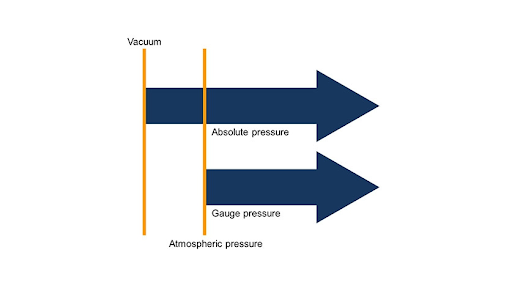
Fig 5. Pressure scale
A real example of absolute pressure in the industry
A real-world example of absolute pressure in the industry is its application in the oil and gas industry, particularly in offshore drilling operations.
Offshore drilling rigs extract oil and gas from beneath the ocean floor. The process involves drilling wells deep into the seabed to reach oil and gas reservoirs. During drilling, absolute pressure measurements are crucial for various aspects of the operation:
- Wellbore Integrity: Absolute pressure measurements are used to monitor the pressure at different depths within the wellbore. This information helps ensure the integrity of the wellbore by detecting any abnormal pressure changes that could indicate potential issues like formation fluid influx or loss of drilling fluid.
- Drilling Mud Control: Drilling mud, a mixture of water, clay, and additives, is used to cool and lubricate the drill bit, remove cuttings, and maintain pressure in the wellbore. Absolute pressure sensors are installed on the mud pumps to ensure that the drilling mud is pumped at the right pressure and flow rate to optimize drilling efficiency.
- Blowout Preventers (BOPs): BOPs are safety systems installed at the wellhead to control and contain well pressure during drilling operations. Absolute pressure gauges are employed to monitor the pressure inside the BOP stack and ensure it can handle the well's pressure effectively.
- Casing and Cementing: Absolute pressure measurements are taken during the casing and cementing process to ensure the integrity of the well. The correct placement of casing and cement ensures that the well is sealed and can withstand the pressure from the reservoir.
- Formation Evaluation: Absolute pressure data is combined with other measurements, such as temperature and resistivity, to evaluate the properties of the formations penetrated by the drill bit. This information is vital for assessing the potential productivity of the well.
Throughout the drilling process, continuous and accurate absolute pressure measurements help prevent well control incidents and ensure the safety of personnel and equipment. By monitoring and controlling the pressure at various stages, drilling operators can optimize the drilling process, improve efficiency, and mitigate potential risks.
Some practical examples of absolute pressure
Here are some practical examples of how absolute pressure is used in various contexts:
- Tire Pressure: When checking the pressure in a car tire, the gauge typically displays the gauge pressure, which is the pressure above atmospheric pressure. To calculate the absolute pressure inside the tire, you would add the atmospheric pressure to the gauge pressure. This is important for maintaining proper tire inflation and ensuring safe driving conditions.
- Scuba Diving: Scuba divers rely on absolute pressure measurements to monitor the pressure in their diving tanks. The pressure gauge on the dive equipment displays the gauge pressure, indicating the pressure above atmospheric pressure. By adding the atmospheric pressure to the gauge reading, divers can determine the absolute pressure inside the tank, which helps manage their air supply and plan safe dives.
- Weather Forecasting: Meteorologists use absolute pressure measurements to analyze weather systems and make predictions. Changes in atmospheric pressure indicate the movement and intensity of weather patterns. By measuring the absolute pressure at different locations, meteorologists can track the formation and progression of high and low-pressure systems, enabling more accurate weather forecasts.
- Altitude Measurement: Absolute pressure can be used to estimate altitude or elevation. By comparing the measured absolute pressure with standard atmospheric pressure values at different elevations, it is possible to approximate the height above sea level. This application is useful in aviation, hiking, mountaineering, and surveying.
- Barometric Pressure: Barometric pressure, which is a type of absolute pressure, is used in weather monitoring and forecasting. Barometers measure atmospheric pressure and are used to track changes in weather conditions. Barometric pressure is an important parameter in weather maps and helps indicate changes in weather patterns, such as approaching storms or clearing skies.
- Medical Applications: Absolute pressure measurements play a crucial role in various medical applications. For example, monitoring blood pressure using a sphygmomanometer involves measuring the pressure exerted by the blood against arterial walls. Absolute pressure measurements are also used in monitoring intracranial pressure, respiratory systems, ventilators, and anesthesia machines.
These practical examples illustrate the diverse range of applications where absolute pressure is used, from everyday scenarios like checking tire pressure to specialized fields like scuba diving, weather forecasting, and medical monitoring.
What is the difference between pressure and absolute pressure?
The difference between pressure and absolute pressure lies in the reference point used for measurement. Here's an explanation of each term:
- Pressure: Pressure refers to the force exerted per unit area on a surface. It is a scalar quantity and can be measured relative to different reference points. When the term "pressure" is used without any qualifier, it usually implies gauge pressure.
- Gauge Pressure: Gauge pressure is the pressure measured relative to atmospheric pressure. It indicates the pressure difference between the measured pressure and the surrounding atmospheric pressure. Gauge pressure can be positive or negative, depending on whether it is above or below atmospheric pressure, respectively.
- Absolute Pressure: Absolute pressure, on the other hand, is the total pressure exerted by a fluid, including both the pressure generated by the fluid itself and the atmospheric pressure acting on it. It is measured relative to an absolute reference point, which corresponds to a perfect vacuum.
To put it simply, pressure is often used in contexts where the reference point is assumed to be atmospheric pressure, while absolute pressure includes both fluid pressure and atmospheric pressure.
For example, if a tire pressure gauge reads 35 psi, it is indicating the gauge pressure, which is the pressure above atmospheric pressure. However, if the gauge were to read 35 psi absolute pressure, it would mean that the tire pressure is 35 psi above a perfect vacuum, accounting for both the tire pressure and the atmospheric pressure.
It's important to be clear about the reference point when discussing pressure to avoid confusion or misinterpretation.
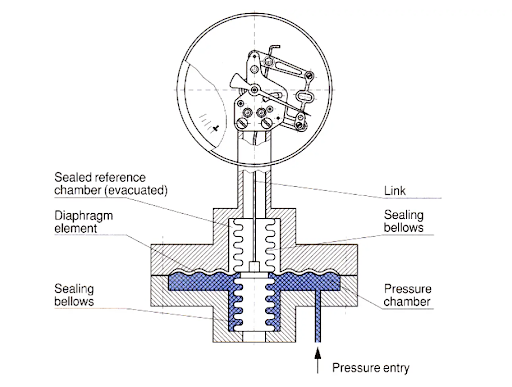
Fig 6. Absolute pressure
What is the difference between absolute and relative pressure?
The difference between absolute pressure and relative pressure lies in the reference point used for measurement and the type of information conveyed. Here's an explanation of each term:
- Absolute Pressure: Absolute pressure is the total pressure exerted by a fluid, including both the pressure generated by the fluid itself and the atmospheric pressure acting on it. It is measured relative to an absolute reference point, which corresponds to a perfect vacuum. Absolute pressure provides the complete measurement of pressure.
- Relative Pressure: Relative pressure, also known as gauge pressure, is the pressure measured relative to a specific reference point, often atmospheric pressure. It indicates the pressure difference between the measured pressure and the reference pressure. Relative pressure does not provide the complete measurement of pressure, as it only captures the difference between the measured pressure and the reference pressure.
To summarize:
- Absolute pressure includes both the pressure exerted by the fluid and the atmospheric pressure, measured relative to a perfect vacuum.
- Relative pressure, or gauge pressure, indicates the pressure difference between the measured pressure and a specific reference point, typically atmospheric pressure.
For example, if a pressure gauge on a tire reads 35 psi, it is indicating the gauge pressure, which is the pressure above atmospheric pressure. However, if the gauge were to read 35 psi absolute pressure, it would mean that the tire pressure is 35 psi above a perfect vacuum, accounting for both the tire pressure and the atmospheric pressure.
It's important to consider the reference point and the type of pressure being measured to ensure clear and accurate communication about pressure values.
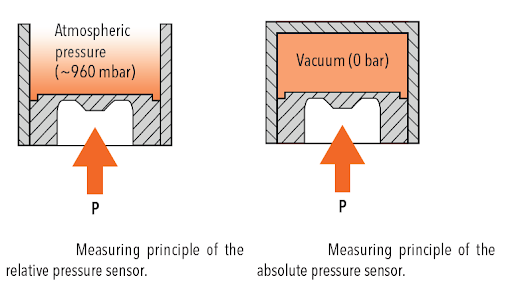
Fig 7. Measuring relative and absolute pressure
What is the difference between absolute and vacuum pressure?
The difference between absolute pressure and vacuum pressure lies in the reference point used for measurement and the type of information conveyed. Here's an explanation of each term:
- Absolute Pressure: Absolute pressure is the total pressure exerted by a fluid, including both the pressure generated by the fluid itself and the atmospheric pressure acting on it. It is measured relative to an absolute reference point, which corresponds to a perfect vacuum. Absolute pressure provides the complete measurement of pressure.
- Vacuum Pressure: Vacuum pressure, on the other hand, refers to the pressure below atmospheric pressure. It is the pressure measured below the reference point of atmospheric pressure. Vacuum pressure is often used when measuring pressures that are lower than atmospheric pressure.
To summarize:
- Absolute pressure includes both the pressure exerted by the fluid and the atmospheric pressure, measured relative to a perfect vacuum.
- Vacuum pressure refers specifically to pressures below atmospheric pressure.
When the absolute pressure is higher than atmospheric pressure, it is positive and referred to as gauge pressure. When the absolute pressure is lower than atmospheric pressure, it is negative and referred to as vacuum pressure.
For example, if a pressure gauge reads 10 psi absolute pressure, it means the pressure is 10 psi above a perfect vacuum. On the other hand, if a pressure gauge reads -5 psi vacuum pressure, it means the pressure is 5 psi below atmospheric pressure.
Understanding the difference between absolute pressure and vacuum pressure is important when dealing with pressure measurements, particularly when pressures are below atmospheric conditions.

Fig 8. Vacuum and absolute pressure
Conclusion
In conclusion, absolute pressure refers to the total pressure exerted by a fluid, including both the pressure generated by the fluid itself and the atmospheric pressure acting on it. It is measured relative to an absolute reference point, which is typically a perfect vacuum.
Absolute pressure is used in various industries and applications, including industrial processes, HVAC systems, weather forecasting, altitude measurement, medical applications, aerospace and aviation, scientific research, and pressure testing and calibration.
It is important to distinguish between absolute pressure and other types of pressure measurements, such as gauge pressure, vacuum pressure, or relative pressure, as they have different reference points and convey different information. The units used for measuring absolute pressure are typically pascals (Pa), but other units like bar, kilopascals (kPa), and psi are also commonly used.
Understanding and accurately measuring absolute pressure are crucial for maintaining safety, optimizing processes, and advancing scientific understanding in many fields.
To recap
Here are 10 frequently asked questions about absolute pressure along with their answers:
- What is absolute pressure?
Absolute pressure is the total pressure exerted by a fluid, including both the pressure generated by the fluid itself and the atmospheric pressure acting on it.
- How is absolute pressure different from gauge pressure?
Absolute pressure includes both the pressure of the fluid and the atmospheric pressure, while gauge pressure is the pressure measured relative to atmospheric pressure.
- What are some common units for measuring absolute pressure?
Common units for measuring absolute pressure include pascals (Pa), bar, kilopascals (kPa), and psi.
- How is absolute pressure measured?
Absolute pressure can be measured using instruments such as mercury barometers, Bourdon gauges, manometers, absolute pressure transducers, or digital pressure gauges.
- What are the practical applications of absolute pressure?
Absolute pressure is used in industrial processes, HVAC systems, weather forecasting, altitude measurement, medical applications, aerospace and aviation, scientific research, and pressure testing and calibration.
- How does absolute pressure relate to altitude?
Absolute pressure can be used to estimate altitude. By comparing the measured absolute pressure with standard atmospheric pressure values at different elevations, it is possible to approximate the height above sea level.
- Can absolute pressure be negative?
No, absolute pressure is always positive or zero. Negative pressure is referred to as vacuum pressure.
- What is the reference point for measuring absolute pressure?
The reference point for measuring absolute pressure is typically a perfect vacuum, which corresponds to zero pressure.
- How does absolute pressure affect weather patterns?
Changes in absolute pressure, also known as barometric pressure, provide valuable information for weather forecasting and indicate the movement and intensity of weather systems.
- Why is it important to understand absolute pressure in various fields?
Understanding absolute pressure is crucial for maintaining safety, optimizing processes, making accurate weather predictions, monitoring medical conditions, ensuring proper functioning of equipment, and advancing scientific knowledge in fields like fluid dynamics and atmospheric studies.
References
https://goodfangsm.life/product_details/3009752.html
https://www.quora.com/Do-pressure-gauges-measure-absolute-pressure
https://instrumentationtools.com/absolute-pressure-gauges-principle/
Recent Posts
-
Booster Pump Troubleshooting and Maintenance: How to Fix and Prevent Common Issues
1. Introduction Imagine turning on your faucet only to be greeted with a weak trickle of water when …22nd Apr 2025 -
Energy-Efficient Booster Pumps: Selection and Tips for Maximizing Performance
1. Introduction Imagine never having to deal with fluctuating water pressure, noisy pumps, or skyroc …19th Apr 2025 -
Booster Pumps for Sustainable Water Systems: Irrigation and Rainwater Harvesting Solutions
1. Introduction Water scarcity is no longer a distant threat—it’s a reality affecti …16th Apr 2025

